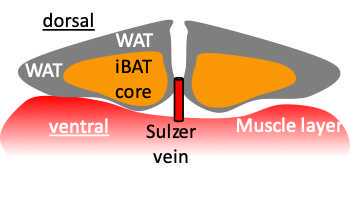Bilateral Adeno-associated virus (AAV) injection into interscapular brown adipose tissue
Heike Muenzberg
Abstract
Protocol details how to inject AAV virus into each interscapular brown adipose tissue fat pad in the mouse.
Before start
Approval of Institutional Biosafety Committee (IBC) to work with AAV
Approval of Institutional Animal Care and Use Committee (IACUC) to perform AAV injections in animals
Steps
Surgery
Place a sterile towel on the surgery platform over the heating mat, another sterile towel in the anesthesia induction chamber.
Record the mouse’s body weight to prepare syringes for saline and analgesia treatment.
Warm saline (1-1.5 mL for 25 g body weight); bupivacaine/lidocaine (2.5-12.5 mg/kg body weight); carprofen (5-10 mg/kg body weight).
Induce anesthesia with 5% isoflurane in induction chamber.
Place the mouse on the surgery platform and maintain anesthesia via a nose cone at 1.5-2% Isoflurane/oxygen (adjust for each mouse accordingly to breathing and anesthetic depth (e.g. loss of withdrawal reflex)).
Apply eye lubricant to the mouse’s eyes.
Disinfect the lower back of the mouse with 70% ethanol, then administer subcutaneous carprofen injection in the disinfected area.
Check for full withdrawal reflex to ensure anesthetic depth.
Use clippers to shave the interscapular region of the mouse and remove all hair.
Disinfect the skin by three alternating scrubs of Novalsan followed by 70% Isopropyl rubbing alcohol.
Make a midline incision with sharp scissors from the scapula to the neck.
Remove connective tissue underneath the skin incision using a sterile cotton swab and teethed forceps until the interscapular brown adipose tissue (iBAT) depot is fully accessible.
Note: The iBAT pad (light brown color) is surrounded by a layer of white adipose tissue. We have successfully injected virus dorsally into the iBAT, however, we could increase our PRV infection success rate by placing the injections into the iBAT core and accessing the ventral iBAT site. The rostral portion of the iBAT depot is detached from the interscapular muscle and the iBAT lobe is flipped back from the rostral side. This will allow visibility of the main iBAT vein (Sulzer vein) and injections are placed from the ventral iBAT side (see Figure 1).

Cover the iBAT with a saline soaked sterile gauze to keep the tissue from drying, then prepare the Hamilton syringe for injection.
AAV6 is considered a BSL1 pathogen, therefore viruses do not require preparation under a laboratory fume hood. However, to ensure aseptic technique, we line an area of the lab bench with aluminum foil and prepare the virus over the aluminum foil. Once surgery is complete, aluminum foil is disposed of in biohazard and area is sanitized.
Fill the Hamilton syringe with 25µL, return to the surgery platform with the Hamilton syringe to begin the injections.
Remove the saline-soaked gauze from the brown adipose tissue and locate the brown adipose tissue pad.
Administer (5) 2.5µL injections into the right iBAT pad and (5) 2.5µL injections into the left iBAT pad. Hold the syringe in place for ~30 seconds after each injection to minimalize backflow, slowly pull the syringe out of the BAT while holding a sterile cotton swab on the site of injection to dry of any possible virus leakage.
Place a sterile, saline-soaked gauze on top of the brown adipose tissue and clean the syringe over aluminum foil. Flush the syringe 5x with 70% EtOH, then flush 5x with distilled H2O.
Collect all liquid as biohazard waste.
Remove the saline-soaked gauze from the brown adipose tissue and with a sterile cotton swab and teethed forceps, reposition the overlaying white adipose tissue back to its original location prior to your incision.
With the teethed and tissue forceps align both sides of the incision properly, and apply wound clips (~25 mm apart, to ensure proper blood circulation).
Inject bupivacaine/lidocaine subcutaneously around the incision site.
Remove mouse from bite bar and administer intraperitoneal injection of warm saline for rehydration.
Place the unconscious mouse in a fresh cage with one cage side on a heating mat and monitor until startling reflexes are restored.
Replenish all consumables (sterile cotton swabs, sterile gauze) and use 70% ethanol to clean surgical tools and place in glass bead sterilizer for 15-20 seconds before additional surgeries.

